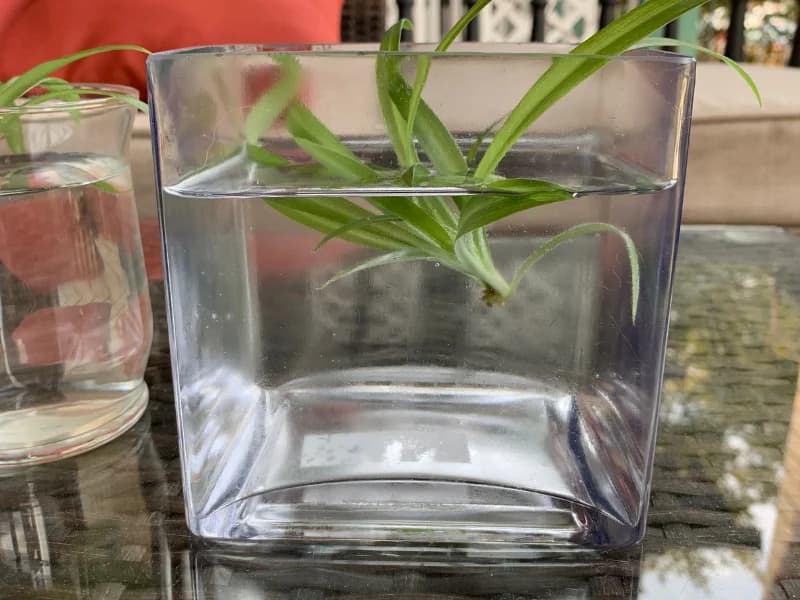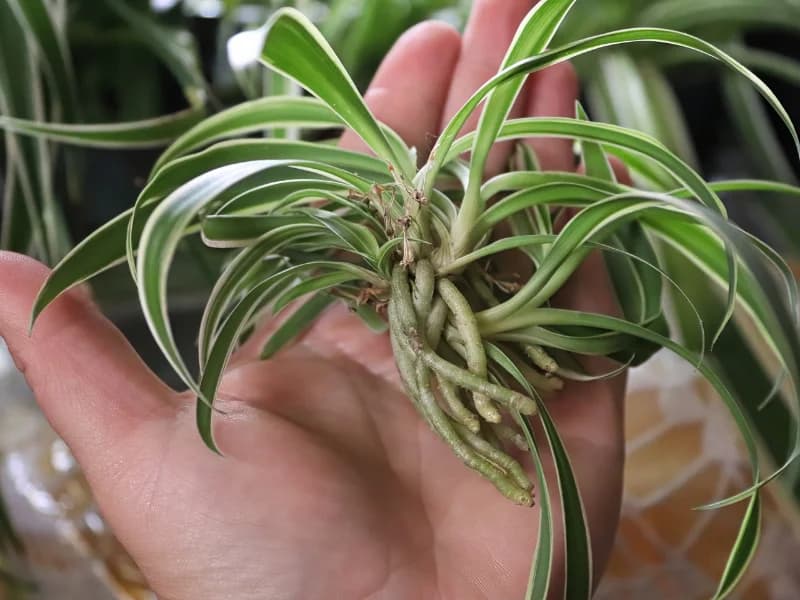Written by Hannah Kingston on October 12, 2021
Spider plants are popular plants that are beautiful, easy to grow, and beneficial to have in your home or office because they serve as air purifiers. Spider plants are also known as Chlorophytum comosum, as well as “hens and chickens”.
Spider plants grow to 60cm high and 60cm wide in their pots. The foliage is ribbon-like, strappy, mid-green and variegated. Spider plants thrive in tropical and cool temperatures. They require well-drained soils as well as bright indirect light.
Spider plants sometimes produce small greenish-white flowers on their stalks as well as flower stems on the plantlets at their tips. Spider plants enjoy moist but not wet soils, tolerate dry conditions and prefer controlled-release fertiliser directly into the container.
There are a number of reasons you may decide you would like to propagate your plant, perhaps you are hoping to grow more of the same species or you would like to tidy up a spider plant that has been growing upwards and outwards rapidly.
How to propagate spider plants
Spider plant grows from a fleshy root. Spider plant roots are called tubers.
Each spider plant is can grow multiple tubers which means that growth can range both upwards and outwards. Each plant is capable of producing multiple tubers, resulting in rapid spread over large areas if these are not lifted, separated and only a few replanted.
Spider plant’s flowers are small, white-green and in clusters on arching stems that grow 75cm or longer. The tip of each stem produces a small bunch of leaves. When these plantlets come into contact with the soil or potting mix, they form roots and new plants form. These are the ‘spiderettes’ or ‘chickens’ of the mother plant.
Spider plants can create their own web as they grow outwards, so if you are growing spider plants in your garden, they may naturally reproduce and propagate. If you are growing spider plants in a pot, it is also possible to replicate this propagation process in a couple of simple steps.

1. Cut 1-2 inches below the tuber root
2. Fill a jar or glass with this non-chlorinated water and set the cutting into the container with the bulk of its leaves outside the liquid.
3.Place the jar and cutting in indirect light until it has developed roots. This is a fairly quick process.
4. Change the water frequently.
5. Once rooting is established, the new plant needs nutrients for future development. Plant in soil once white roots begin to develop at the bottom of the plantlet.
Should I cut the babies off my spider plant?
Spider plants are often described as ‘the perfect indoor plant’ because it needs minimal care and is very efficient at improving air quality in buildings. The only issue with spider plants is that they can grow wide and fast.
Spiderettes refer to the overgrowth of spider plants. To remove the spiderettes, cut the long stems back to the base from both the mother plant and the baby. For overgrown or pot bound plants, repotting in addition to pruning may be necessary. After pruning, repot the spider plant, giving it a good root pruning as well prior to returning it to the pot of fresh soil. Generally, it’s a good idea to include root pruning at least once every year or two.

How do you propagate a spider plant in water?
Growing a spider plant in water is a first step to starting a new plant but not a sustainable system. Spider plants produce little tufted growths at the end of their stems. These can be taken off the main plant and allowed to grow roots as separate plants.
The best way to propagate the plant is to cut the plantlet from the stolon with clean, sharp scissors. Use demineralized water or let your tap water sit for a day before placing the plantlet in the liquid. Fill a jar or glass with this non-chlorinated water and set the cutting into the container with the bulk of its leaves outside the liquid. Place the cutting in indirect light until it has developed roots. This is a fairly quick process. Frequent water changes are essential to good spider plant water cultivation.
Can I cut the brown tips off my spider plant?
You do not have to cut off the brown tips, but you could if you want to. Brown tips on their own do not harm or damage the plant but to keep the plant looking fresh, you may make the decision to cut the brown tips off your plant.
Brown leaves represent dead tissue on the plant that dries off and in some cases becomes papery to the touch and drops off on contact. This is caused by an underlying issue that can be treated, but the old leaves are not going to fix themselves.
Do spider plants need a lot of water?
Caring for spider plants is easy. These tough plants tolerate lots of abuse, making them excellent candidates for newbie gardeners or those without a green thumb. Provide them with well-drained soil and bright, indirect light and they will flourish. Water them well but do not allow the plants to become too soggy, which can lead to root rot.
Do spider plants like clay pots?
Choose a pot that is 1 to 2 inches larger than the pot in which the spider plant is currently housed. Make sure that the pot is well-draining, with plenty of drainage holes in the bottom. Clay pots often wick water from the soil, making them a poor choice for spider plants.
Spider plants will grow in a wide range of soils including general-purpose potting soil provided that it does not contain fertilizer with significant amounts of fluoride, since this mineral can damage the plant’s tissues.
How do I make my spider plant bushier?
The key to making your spider plant bushier is to meet all of its care needs and prune and repot it as soon as it is needed.This will maximize your spider plant’s overall bushiness and allow it to grow to its full potential.
It also helps to fill in the plant with a few of the spiderettes that you cut away when pruning.Use a sharp sterilized scissors when pruning and remove all of the foliage that looks diseased, discolored, or dead.
When removing the spiderettes, cut the long stem connecting the mother and baby plant at the base. And as mentioned earlier, you can use a few of the spiderettes to fill out your spider plant. But, at the end of the day, you’re not going to have a bushy spider plant if you don’t take good care of its basic needs.